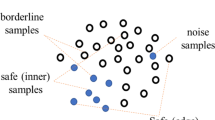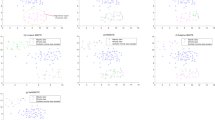Abstract
The problem of limited minority class data is encountered in many class imbalanced applications, but has received little attention. Synthetic over-sampling, as popular class-imbalance learning methods, could introduce much noise when minority class has limited data since the synthetic samples are not i.i.d. samples of minority class. Most sophisticated synthetic sampling methods tackle this problem by denoising or generating samples more consistent with ground-truth data distribution. But their assumptions about true noise or ground-truth data distribution may not hold. To adapt synthetic sampling to the problem of limited minority class data, the proposed Traso framework treats synthetic minority class samples as an additional data source, and exploits transfer learning to transfer knowledge from them to minority class. As an implementation, TrasoBoost method firstly generates synthetic samples to balance class sizes. Then in each boosting iteration, the weights of synthetic samples and original data decrease and increase respectively when being misclassified, and remain unchanged otherwise. The misclassified synthetic samples are potential noise, and thus have smaller influence in the following iterations. Besides, the weights of minority class instances have greater change than those of majority class instances to be more influential. And only original data are used to estimate error rate to be immune from noise. Finally, since the synthetic samples are highly related to minority class, all of the weak learners are aggregated for prediction. Experimental results show TrasoBoost outperforms many popular class-imbalance learning methods.
Similar content being viewed by others
Explore related subjects
Discover the latest articles and news from researchers in related subjects, suggested using machine learning.References
He H, Garcia E A. Learning from imbalanced data. IEEE Transactions on Knowledge and Data Engineering, 2009, 21(9): 1263–1284
Liu X Y, Wu J, Zhou Z H. Exploratory undersampling for classimbalance learning. IEEE Transactions on Systems, Man, and Cybernetics, Part B (Cybernetics), 2009, 39(2): 539–550
Cieslak D, Chawla N. Learning decision trees for unbalanced data. In: Proceedings of the Joint European Conference on Machine Learning and Knowledge Discovery in Databases. 2008, 241–256
Galar M, Fernandez A, Barrenechea E, Bustince H, Herrera F. A review on ensembles for the class imbalance problem: bagging-, boosting-, and hybrid-based approaches. IEEE Transactions on Systems, Man, and Cybernetics, Part C (Applications and Reviews), 2012, 42(4): 463–484
Wang S, Minku L L, Yao X. Resampling-based ensemble methods for online class imbalance learning. IEEE Transactions on Knowledge and Data Engineering, 2015, 27(5): 1356–1368
Yan Y, Chen M, Shyu M L, Chen S C. Deep learning for imbalanced multimedia data classification. In: Proceedings of the 2015 IEEE International Symposium on Multimedia. 2015, 483–488
Wang S, Liu W, Wu J, Cao L, Meng Q, Kennedy P J. Training deep neural networks on imbalanced data sets. In: Proceedings of the 2016 International Joint Conference on Neural Networks. 2016, 4368–4374
Fawcett T, Provost F J. Combining data mining and machine learning for effective user profiling. In: Proceedings of the 2nd International Conference on Knowledge Discovery and Data Mining. 1996, 8–13
Kubat M, Holte R C, Matwin S. Machine learning for the detection of oil spills in satellite radar images. Machine Learning, 1998, 30(2–3): 195–215
Lewis D D, Ringuette M. A comparison of two learning algorithms for text categorization. In: Proceedings of the 3rd Annual Symposium on Document Analysis and Information Retrieval. 1994, 81–93
Wang S, Yao X. Using class imbalance learning for software defect prediction. IEEE Transactions on Reliability, 2013, 62(2): 434–443
Bradley A P. The use of the area under the ROC curve in the evaluation of machine learning algorithms. Pattern Recognition, 1997, 30(6): 1145–1159
Yang Q, Wu X. 10 challenging problems in data mining research. International Journal of Information Technology and Decision Making, 2006, 5(4): 597–604
Weiss G M. Mining with rarity: a unifying framework. ACM SIGKDD Explorations Newsletter, 2004, 6(1): 7–19
Weiss G M. Mining with Rare Cases. Data Mining and Knowledge Discovery Handbook, Springer, Boston, MA. 2005, 765–776
Khoshgoftaar T M, Seiffert C, Hulse J V, Napolitano A, Folleco A. Learning with limited minority class data. In: Proceedings of the 6th International Conference on Machine Learning and Applications. 2007, 348–353
Chawla N V, Bowyer K W, Hall L O, Kegelmeyer W P. SMOTE: synthetic minority over-sampling technique. Journal of Artificial Intelligence Research, 2002, 16: 321–357
Han H, Wang W Y, Mao B H. Borderline-SMOTE: a new oversampling method in imbalanced data sets learning. In: Proceedings of the International Conference on Intelligent Computing. 2005, 878–887
Batista G E, Prati R C, Monard MC. A study of the behavior of several methods for balancing machine learning training data. ACM SGKDD Explorations Newsletter, 2004, 6(1): 20–29
Laurikkala J. Improving identification of difficult small classes by balancing class distribution. In: Proceedings of the 8th Conference on Artificial Intelligence in Medicine in Europe. 2001, 63–66
He H, Bai Y, Garcia E A, Li S. ADASYN: adaptive synthetic sampling approach for imbalanced learning. In: Proceedings of the 2008 IEEE International Joint Conference on Neural Networks. 2008, 1322–1328
Das B, Krishnan N C, Cook D J. wRACOG: a gibbs sampling-based oversampling technique. In: Proceedings of the 13th IEEE International Conference on Data Mining. 2013, 111–120
Zhang H, Li M. RWO-sampling: a random walk over-sampling approach to imbalanced data classification. Information Fusion, 2014, 20: 99–116
Pan S J, Yang Q. A survey on transfer learning. IEEE Transactions on Knowledge and Data Engineering, 2010, 22(10): 1345–1359
Galar M, Fernández A, Barrenechea E, Herrera F. EUSBoost: enhancing ensembles for highly imbalanced data-sets by evolutionary undersampling. Pattern Recognition, 2013, 46(12): 3460–3471
Ramentol E, Caballero Y, Bello R, Herrera F. SMOTE-RSB*: a hybrid preprocessing approach based on oversampling and undersampling for high imbalanced data-sets using SMOTE and rough sets theory. Knowledge and Information Systems, 2012, 33(2): 245–265
Wang S, Yao X. Multiclass imbalance problems: analysis and potential solutions. IEEE Transactions on Systems, Man, and Cybernetics, Part B (Cybernetics), 2012, 42(4): 1119–1130
Liu X Y, Li Q Q. Learning from combination of data chunks for multiclass imbalanced data. In: Proceedings of the 2014 International Joint Conference on Neural Networks. 2014, 1680–1687
Li S, Wang Z, Zhou G, Lee S Y M. Semi-supervised learning for imbalanced sentiment classification. In: Proceedings of the 20th International Joint Conference on Artificial Intelligence. 2011, 1826–1832
Zhang M L, Li Y K, Liu X Y. Towards class-imbalance aware multilabel learning. In: Proceedings of the 24th International Joint Conference on Artificial Intelligence. 2015, 4041–4047
Hoens T R, Chawla N V. Learning in non-stationary environments with class imbalance. In: Proceedings of the 18th ACM SIGKDD International Conference on Knowledge Discovery and Data Mining. 2012, 168–176
Wang S, Minku L L, Yao X. Resampling-based ensemble methods for online class imbalance learning. IEEE Transactions on Knowledge and Data Engineering, 2015, 27(5): 1356–1368
Cao H, Li X L, Woon Y K, Ng S K. SPO: structure preserving oversampling for imbalanced time series classification. In: Proceeding of the 11st IEEE International Conference on Data Mining. 2011, 1008–1013
Cao H, Li X L, Woon D Y K, Ng S K. Integrated oversampling for imbalanced time series classification. IEEE Transactions on Knowledge and Data Engineering, 2013, 25(12): 2809–2822
Chawla N V, Lazarevic A, Hall L O, Bowyer K W. SMOTEBoost: improving prediction of the minority class in boosting. In: Proceedings of the 7th European Conference on Principles and Practice of Knowledge Discovery in Databases. 2003, 107–119
Wang S, Yao X. Diversity analysis on imbalanced data sets by using ensemble models. In: Proceedings of IEEE Symposium on Computational Intelligence and Data Mining. 2009, 324–331
Sun Y, Kamel M S, Wong A K, Wang Y. Cost-sensitive boosting for classification of imbalanced data. Pattern Recognition, 2007, 40(12): 3358–3378
Seiffert C, Khoshgoftaar T M, Van Hulse J, Napolitano A. RUSBoost: a hybrid approach to alleviating class imbalance. IEEE Transactions on Systems, Man and Cybernetics, Part A (Systems and Humans), 2010, 40(1): 185–197
Tomek I. Two modifications of CNN. IEEE Transactions of System Man Cybernetics, 1976, 6: 769–772
Raina R, Battle A, Lee H, Packer B, Ng A Y. Self-taught learning: transfer learning from unlabeled data. In: Proceedings of the 24th International Conference on Machine Learning. 2007, 759–766
Wei Y, Zhu Y, Leung C W, Song Y, Yang Q. Instilling social to physical: co-regularized heterogeneous transfer learning. In: Proceedings of the 13rd AAAI Conference on Artificial Intelligence. 2016, 1338–1344
Weiss K, Khoshgoftaar T M, Wang D. A survey of transfer learning. Journal of Big Data, 2016, 3(1): 1–40
Al-Stouhi S, Reddy C K. Transfer learning for class imbalance problems with inadequate data. Knowledge and Information Systems, 2016, 48(1): 201–208
Ge L, Gao J, Ngo H, Li K, Zhang A. On handling negative transfer and imbalanced distributions in multiple source transfer learning. Statistical Analysis and Data Mining, 2014, 7(4): 254–271
Dai W, Yang Q, Xue G R, Yu Y. Boosting for transfer learning. In: Proceedings of the 24th International Conference on Machine Learning. 2007, 193–200
Blake C, Keogh E, Merz C J. UCI repository of machine learning databases. University of California, Irvine, CA, 1996
Breiman L, Friedman J, Olshen R A, Stone C J. Classification and Regression Trees. London: Routledge Press, 2017
Schapire R E. A brief introduction to Boosting. In: Proceedings of the 16th International Joint Conference on Artificial Intelligence. 1999, 1401–1406
Barandela R, Valdovinos R M, Snchez J S. New applications of ensembles of classifiers. Pattern Analysis and Applications, 2003, 6(3): 245–256
Breiman L. Bagging predictors. Machine Learning, 1996, 24(2): 123–140
Acknowledgements
The authors wish to thank the associate editor and anonymous reviewers for their helpful comments and suggestions. This work was supported by the National Key R&D Program of China (2017YFB1002801), the National Natural Science Foundation of China (Grant Nos. 61473087, 61573104), the Natural Science Foundation of Jiangsu Province (BK20141340), and partially supported by the Collaborative Innovation Center of Novel Software Technology and Industrialization.
Author information
Authors and Affiliations
Corresponding author
Additional information
Xu-Ying Liu received the BS degree in computer science from Nanjing University of Aeronautics and Astronautics, China, the MS and PhD degrees in computer science from Nanjing University, China in 2006 and 2010, respectively. Now she is an assistant professor at the School of Computer Science and Engineering, Southeast University, China. Her research interests mainly include machine learning and data mining.
Sheng-Tao Wang, received MS degree in computer science and engineering from Southeast University, China in 2017. He is currently a big data development engineer in Helium Data. His research interests include machine learning and data mining.
Min-Ling Zhang received the BS, MS, and PhD degrees in computer science from Nanjing University, China in 2001, 2004 and 2007, respectively. Currently, he is a professor at the School of Computer Science and Engineering, Southeast University, China. In recent years, Dr. Zhang has served as the Program Co- Chairs of ACML’17, CCFAI’17, PRICAI’16, Senior PC member or Area Chair of AAAI’18/’17, IJCAI’17/’15, ICDM’17/’16, PAKDD’16/’15, etc. He is also on the editorial board of Frontiers of Computer Science, ACM Transactions on Intelligent Systems and Technology, Neural Networks. Dr. Zhang is the secretary-general of the CAAI (Chinese Association of Artificial Intelligence) Machine Learning Society, standing committee member of the CCF (China Computer Federation) Artificial Intelligence & Pattern Recognition Society.
Electronic supplementary material
Rights and permissions
About this article
Cite this article
Liu, XY., Wang, ST. & Zhang, ML. Transfer synthetic over-sampling for class-imbalance learning with limited minority class data. Front. Comput. Sci. 13, 996–1009 (2019). https://doi.org/10.1007/s11704-018-7182-1
Received:
Accepted:
Published:
Issue Date:
DOI: https://doi.org/10.1007/s11704-018-7182-1




